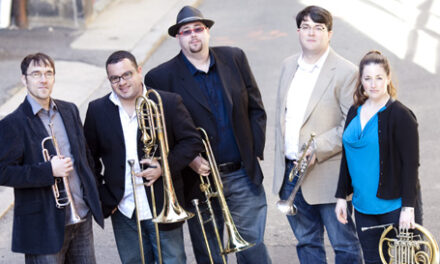We lay our scene at the University of North Carolina School of the Arts in Winston-Salem with the fair Verona Quartet. In their words, the ensemble’s name was chosen as an homage to one of the most celebrated written story tellers, William Shakespeare. While the Verona Quartet’s storytelling is remarkable, what really caught my attention was the ensemble’s vivid use of color. Throughout the program, each member demonstrated the ability to lead and follow in a way that was essential to creating an ensemble color that was vibrant, thoughtful, and nuanced. The smartly programmed recital laid out a rich palette of colors for the quartet and guest clarinetist, Oskar Espina Ruiz to draw from.
Tempestuous and surging, the ensemble’s performance of Schubert’s Quartettsatz in C minor, D. 703 was an opener that beckoned the audience forward to the edge of their seats. After the whirlwind opening, first violinist Jonathan Ong immediately established his strength leading the group with his ambitious and yearning solo passages. In the opposing range, cellist Jonathan Dormand helped set the boundaries of the group’s shapely sound while second violinist Dorothy Ro and violist Abigail Rojansky filled in the core with contagious warmth and sensitivity. Without losing a shred of intensity or novelty, the quartet brought Schubert’s music to a spinning and conclusive resolution.
The real showstopper of the evening was the quartet’s performance of Gabriela Lena Frank‘s (1972) work, Leyendas: An Andean Walkabout (2001). Dormand introduced the piece with a thoughtful explanation of Frank’s compositional intent as well as the narrative and technical characteristics of the six movements. He described how Frank’s identity, which is heavily informed by her Peruvian-Chinese and Lithuanian-Jewish heritage, is at the center of her musical output. From Frank’s website, this particular composition is meant to serve as a vehicle for her concept of “mestizaje” from Peruvian writer José María Arguedas. In this context, Frank interprets metizaje to mean a frame though which cultures can “coexist without the subjugations of one by the other.” Leyendas is a reflection of Andean and Western multiculturalism as it draws on the sounds, instruments, and legends of populations from the South American Andes. Not only is the piece narratively spellbinding, but extended techniques throughout the work accentuated and amplified the quartet’s use of color. I was introduced to an arrangement of Leyendas for chamber orchestra a little over a year ago and was immediately taken by the originality and vitality in Frank’s compositional style. After their enlivened performance of Schubert, I was anxious to hear how the Verona Quartet would interpret a completely different language with Frank’s piece.
To be candid, I was blown away. The first movement, “Toyos,” instantly transported the audience to a completely new musical environment. Based on the sound of Peruvian panpipe, the quartet’s performance of “Toyos” was airy and effervescent. The use of parallel fourths and fifths felt inflatable; like they would never touch the ground. Rojansky led the texture with a breezy flautando which returns later in the third movement. The second movement, “Tarqueada,” was flute-like as well. However, unlike the ease of the panpipe, this movement imitates a tarka – a stark, droning flute that relentlessly beats the air. Beginning intensely and ending in a whisper, the simple featheriness of the panpipe returns for the third movement, “Himno de Zampoñas.” This movement specifically emulates a type of panpipe ensemble that divides up melodies in a musical technique known as hocketing. As if by clockwork, each performer’s sound and physical movements synchronized like musical machinery. Separated by interludes of matching pizzicato and col legno reminiscent of Reich-like minimalism, the synchronism of the group became more mesmerizing with each succession. The last movements of the work depict three popular characters from Incan/Andean scenes: the Chasqui, a fleet-footed messenger of the mountains, the Llorona, a mourning woman with a powerful wailing cry, and the Romanceros, gallant and macho courting musicians. Like a painting of the very figures they portrayed, the quartet played with a commanding and unified sense of characterization. The Verona Quartet’s consummate performance of the work is certain to crystallize Leyendas as one of the contemporary masterworks for string quartet.
After intermission, the Verona Quartet rounded out their performance with another dramatic palette change: Brahms’ Clarinet Quintet in B minor featuring guest soloist and professor of clarinet at UNCSA, Oskar Espina Ruiz. Espina Ruiz, much like the Verona Quartet, is highly artistically acclaimed. After giving way to the exposition of the first theme, the quartet members took a step back and let Espina Ruiz’s buoyant tone shine through. Using his first notes in the Brahms quintet to paint a setting both nostalgic and wistful, Espina Ruiz’s addicting tone drew the audience in for one of Brahms’ greatest compositions. This was a dramatic and brilliantly coordinated performance to be sure, but it was the earworms from Leyendas that I found myself humming after the concert for several days on. The quintet certainly used new paints for their performance of Brahms, but it was with Frank that the Verona Quartet was able to show off their skills of blending and brushstrokes.











